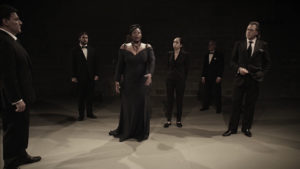
Teatro Grattacielo 2020 Review: Fedora
Reimagining ‘Fedora’ for the Modern Reality
By Polina LyapustinaWith Christmas approaching, more and more opera companies — big and small, having no alternative in view, have come to accept the online space as their new address. But still, this new home seems alien and risky. There’s so much to be afraid of, to avoid, to make mistakes with. Streams remain uncharted lands for the opera artists and video professionals have yet to fully adapt to the industry needs.
While major opera houses reflect on the advisability of filming and showing new productions, more flexible independent opera companies are paving their own, difficult ways on screens. They simply have no more time to wait.
Trying to stay afloat, smaller productions face the biggest challenges. How to fund a production is the very first big question, and certainly the most difficult one. But there are many others.
How do you meet the audience’s expectations in the set design, sound quality? How do you find the right video producer? Where do you film? Where does the orchestra fit in? How do performers act while maintaining social distance?
But fortunately, there’s another topic — the one with a very bright and clear response: Who will sing? The number of singers out of work is incalculable. And every artist getting a job, especially in a new production, surely brings all their energy and skill to show the best result. So when I see various modern productions refusing to use an expensive set design or the big orchestras, I know exactly what they are betting on.
Accepting the New Rules
Teatro Grattacielo’s darker, sepia-toned “Fedora,” as directed by Malena Dayen, is an opera you need to see today. It’s here to give you hope, that tomorrow exists even for those collectives who are now forced to abandon even the most familiar basis of opera performance but not giving up on the big artform’s potential as a chamber concert format. And in “Fedora,” you can see how everything that has been cut off can be replaced and enriched with a vengeance using smart and witty solutions.
Minimalist and modern in the set design, Dayen’s version of the work is highly rich in emotions. The light, the very technical harmonization of the voices and piano, the acting — it all hits to the heart when we are devoid of distractions such as decorations and costumes.
Finally, the close-ups don’t force the eyes to concentrate on the details we never needed, but let us get closer to the singers and their special artistic approaches. I do believe, that the personality of Michelle Johnson, her endless pleasure of singing, made the soprano a convincing Fedora more than any princess dresses could ever do. And the big and devoted eyes of mezzo-soprano Eugenia Forteza built her character and defined her role before she sang her first tune.
The single piano accompaniment occasionally complemented by fisarmonica is surely not the orchestra, but conductor Israel Gursky makes it sound brighter, and surely more suitable inside these brick walls. His reading of the late 19th-century score is bold and not afraid of silence. His piano lines can both argue with the vocal lines and support them, as the reality of the play can both hit or cheer the characters.
#GirlPower
When I think about Giordano’s “Fedora,” I immediately recall a recent independent “Study of Systemic Discrimination Against Women in Opera.” The source itself might surely be a bright example of such discrimination — though the title role is written for the soprano, 10 male roles against only three females ruin all the joy.
But fortunately, Teatro Grattacielo’s “Fedora” fights these sad statistics with its special courage and charm. The choices for the main characters are simply incomparable. Michelle Johnson in the title role is simply irresistible. She maintains her voice on full power throughout the whole performance but manages to smoothly transform it into a deep and gentle tone in her last minutes.
Maria Brea, who created the role of Countess Olga with her seemingly unfettered vocal abilities, conquers the entire stage with her every appearance. Her cheerful soprano fully reflected the sparkling temper of her heroine. Forteza and soprano Kinneret Ely in their shorter roles also bring an absolutely special sound into the cold surrounding.
Jeremy Brauner used his tenor voice to the maximum. Though his voice often overmodulated on the recorded track (no doubt a recording challenge rather a vocal one), the range of the emotions that he managed to convey, made his character amazingly credible.
Another standout was baritone Marcello Guzzo, who portrayed De Siriex with incredible vocal polish and elegance.
The rest of the cast, including Rubin Casas, Michael Gracco, Brian Montgomery, Jordan Weatherston Pitts, Pavel Suliandziga, William Desbiens, and Rick Agster, also proved to be very talented in interpreting their roles. Unfortunately, there were some major inconsistencies in how their voices were picked up by the microphones during major ensembles, resulting in some inconsistencies in the overall sound quality.
Desperate times call for desperate measures. And here, today we see the earliest brave results of first attempts. Attempts to reach the audience that is locked inside their homes and inside their anxious minds, those who barely reach out any further than their TVs.
Opera companies today call for their audience, “Come and see, we are still here. But now we are different. Even doing what we did our whole life, today we do it differently. Imperfectly and with some mistakes, connected to the technologies we are so far from. But we will learn, and bring our art to you over and over again.”
And I believe, though today the whole industry is far from the final solution to the problem, the musicians from the Teatro Grattacielo and director Dayen must be happy and proud – they definitely nailed it. And I only hope, they will soon see the response from the audience. Whatever one may say, this is the game of reciprocity.


